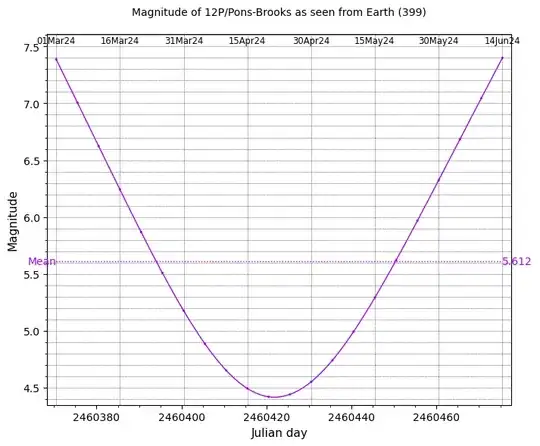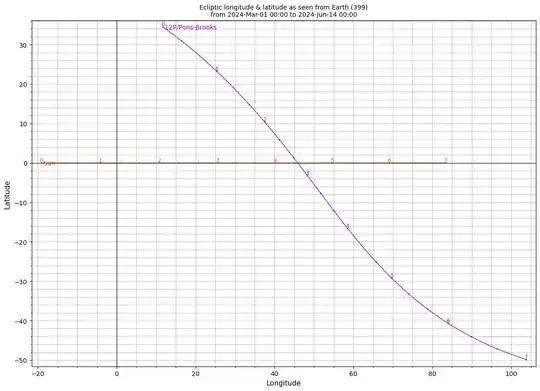As James K said, that's no comet. ;)
12P/Pons–Brooks is a relatively bright comet, but it's certainly not that bright.
On 2024-Mar-26, JPL updated the trajectory data for this comet, which has ID 90000223.
Its orbit has high inclination (74.19°), and it's approaching the ecliptic from the north. It reaches perihelion on 2024-Apr-21. Here's a Horizons plot showing its orbit (purple) and Earth's (blue), using a 5 day time step for 180 days either side of that date, from 2023-Oct-24 to 2024-Oct-18. Plot points are at 0:00 TT. Numeric labels are every 30 days. The orange dot is the Sun, the grey plane is the ecliptic, the dark vertical line is the J2000 equinox line (the +X axis of the ecliptic and equatorial coordinate systems).

It looks better in the interactive 3D view. There's some info about an earlier version of my plotting script here. This version also has a "rainbow" option, which gives dots equal hues at equal times.
It's also interesting to look at the geocentric trajectory of the comet. Just make Earth (ID 399) the Center, and make the Sun (ID 10) one of the Targets.
Here's a plot showing the comet's estimated total magnitude, once again using a 5 day time step. Plot points are at 0:00 UTC.

Here's a plot of the ecliptic latitude and longitude of the Sun and 12P/Pons–Brooks, using the same time step.

This table shows the date corresponding to each numeric label.
| Label |
Date |
| 0 |
2024-Mar-01 |
| 1 |
2024-Mar-16 |
| 2 |
2024-Mar-31 |
| 3 |
2024-Apr-15 |
| 4 |
2024-Apr-30 |
| 5 |
2024-May-15 |
| 6 |
2024-May-30 |
| 7 |
2024-Jun-14 |
The magnitude plotting script can be found at the end of this answer. Note that for comets, the nuclear magnitude replaces the surface brightness. Please see the Horizons manual for details.
The latitude-longitude script is here. It's a minor update to the script in this answer.






